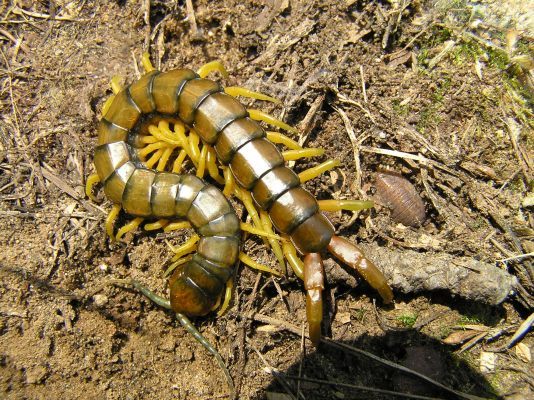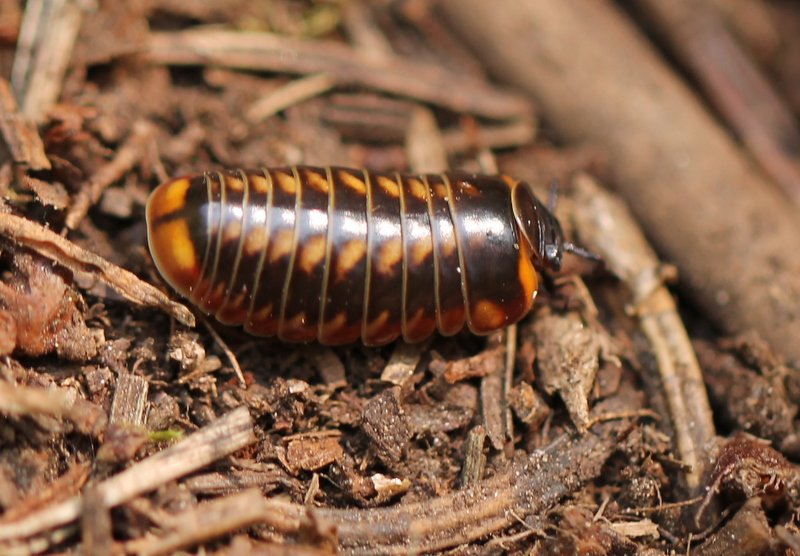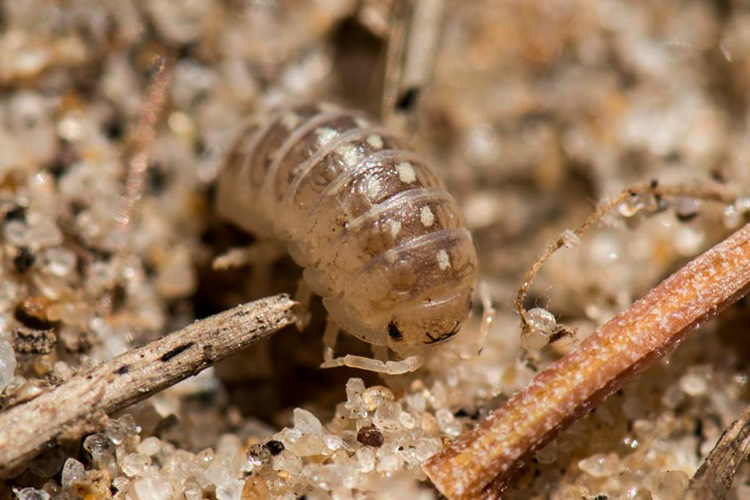|

arachnids |

myriapods & isopods |

molluscs |
 marine
molluscs |
|
|
______________________________________________________________________
THE CENTIPEDES, MILLIPEDES AND WOODLICE OF
Thásos

The Chilopoda (centipedes), Diplopoda
(millipedes) and Isopoda (woodlice) of
Thásos are very poorly known and present
an ideal opportunity to make a substantial contribution to knowledge of the
island's biodiversity. Records for each of these invertebrate groups are
scattered through a handful of scientific papers but I am only aware of a total
of 26 species recorded to date - twelve centipedes, five millipedes and nine
woodlice. Although most of the known species are centipedes, the bulk of the
records come from collections made by Bulgarian scientists in the 1940s and only
identified in recent years (Stoev 2004). Zapparoli (2002) was only able to list
five centipede species from Thásos in his catalogue of the Greek fauna and five
years later Simaiakis et al. (2007), clearly unaware of Stoev's contribution,
could make no additions in their review of the fauna of the North Aegean
islands. I suspect the five species included by Zapparoli (2002) were originally
recorded by Matic & Stavropulos (1988), who described the centipede
Harpolithobius thasosensis as new to science (although this has now been
synonymised with Harpolithobius anodus (Latzel, 1880)).
I have not made any effort to record
centipedes during my visits to Thásos but it's impossible not to be aware of
Scolopendra cingulata when turning stones looking for insects. This large
olive-green species, which can grow to 15 cms in length, occurs from sea level
to the mountain peaks and is a fearsome predator. It has a toxic bite which can
be very painful to Man but is said to be rarely fatal! I can also add a species
to the island list as a house centipede Scutigera coleoptrata was in the
apartment I was staying in at Thassos Town in September 1993. Simaiakis et
al. (2007) report a total of 32 centipede species from the North Aegean islands
but the actual total can be expected to be much higher than this and Thásos
probably holds double or even triple the number of species currently known.

Millipedes were evidently surveyed on Thásos
in 1982 by Beron and Andreev (Mauries, 1985) but I have
not been able to examine a copy of this paper. Their collecting revealed a genus
new to science in the form of Thassoblaniulus simplarius Mauričs 1985 and
presumably other species from the island are mentioned in this work. However,
the only other published record I am aware of is Megaphyllum brachyurum,
which is mentioned by Lazányi & Vagalinski (2013) as occurring on the island. I
have collected examples of two species - Glomeris balcanica (det. Dr S.
Golovatch) from montane limestone pavement at 985 metres a.s.l. on Profitis
Ilias in Oct 2001 and Polyxenus albus (det. M. Nguyen Duy-Jacquemin) from
coastal phrygana at Skala Maries in Sept 1993. Polyxenus is widespread on
the island and I have seen (but not collected) examples around Thassos Town, at
Skala Potamias, at 845 metres a.sl. on Ipsarion and at 940 metres a.sl. on
Profitis Ilias. These records probably also represent P. albus but P.
chalcidicus also occurs in Greece. In addition, I have twice seen
individuals (in coastal grassland east of Thassos Town in May 1997 and at 845
metres a.s.l. amongst limestone scree on Ipsarion in May 2003) of what I have
assumed to be
Ommatoiulus sabulosus, which is a distinctive and common species of dune
systems and dry grassland in Britain. However, Kicaj &
Qirjo (2013) note the occurrence of O. sabulosus in Albania and Bulgaria
but not Greece and therefore these records are unconfirmed.
Strasser & Minelli (1984) list 470
millipede species for Italy and presumably the Greek fauna is of similar
magnitude. Clearly there is much to be done on the millipedes of
Thásos.

Greece appears to be much better studied with regard to its
woodlouse fauna and Alexiou & Sfenthourakis (2013) provide an inventory of the
238 species recorded nationally. Much of this wealth of knowledge is due to the
extensive contributions of the German scientist, Helmut Schmalfuss, who has
studied the isopods of Greece since 1971. However, there are still only nine
species recorded from Thásos and
much must remain to be discovered. As with the other groups here, I have not
paid any particular attention to woodlice on Thásos but have nonetheless added
two species to the island list. Several examples of the characteristic beach
pill-woodlouse Armadillidium album were found under driftwood on the
beach at Cap Prinos on 28 Sept 2001. This species was first found in Greece in
1994 on the mainland coast to the north-east of Thásos and has also been
recorded from Zakinthos (Schmalfuss 2008). In June 2005 Halophiloscia couchii,
which is widespread around the coasts of the Aegean (Alexiou
& Sfenthourakis 2013), was frequent
amongst the shingle on the eastern beach at Aliki. On two occasions I have
observed examples of Platyarthrus in ants' nests: in October 2001 on
montane limestone grassland at 940 metres a.s.l. on Profitis Ilias and in May
2003 from a Messor nest in an old pasture above Thassos Town. P.
lindbergi and P. schoblii are both known from the Aegean islands so
it is not possible to say which species are present on Thásos (though specimens
have been deposited with Anastasios Legakis at the University of Athens so
identification may be forthcoming).
Helmut Schmalfuss visited Thásos in June
1973, May 1997 and May 1999 and presumably recorded several species but the only
published records I have come across are those of Armadillidium insulanum, A.
peraccae (Schmalfuss 2006, 2013), Leptotrichus spinosus (Schmalfuss
2000) and Porcellionides pruinosus (Schmalfuss 1975). He also mentions
the occurrence of Armadillidium vulgare and Porcellio obsoletus (Schmalfuss
1975) on the island. L. spinosus was described as new to science from
specimens discovered under stones in the south-eastern part of the island on a
small sandy beach with a freshwater stream in June 1973 and again on 12 May
1997. Finally, Beron et al. (2004) mention that
Trichoniscus rhodopiensis has been recorded from
Thásos.
CHECKLIST
CHILOPODA
Geophilomorpha
Clinopodes flavidus C.L. Koch, 1847
Henia illyrica (Meinert, 1870)
Himantarium gabrielis (Linnaeus,
1767)
Pachymerium ferrugineum (C.L. Koch, 1835)
Stigmatogaster gracilis (Meinert, 1870)
Lithobiomorpha
Eupolybothrus litoralis (L. Koch, 1867)
Harpolithobius anodus (Latzel, 1880)
Scolopendromorpha
Cryptops anomalans Newport, 1844
Cryptops dianae Stavropoulos & Matic, 1990
Cryptops hortensis (Donovan, 1810)
Scolopendra cingulata Latreille, 1829
Scutigeromorpha
Scutigera coleoptrata (Linnaeus, 1758)
DIPLOPODA
Blaniulidae
Thassoblaniulus simplarius
Mauričs 1985
Glomeridae
Glomeris balcanica Verhoeff, 1906
Megaphyllum brachyurum (Attems, 1899)
Julida
Ommatoiulus cf.sabulosus (Linnaeus, 1758)
Polyxenida
Polyxenus albus Pocock, 1894
ISOPODA
Armadillidiidae
Armadillidium album Dollfus, 1887
Armadillidium insulanum Verhoeff, 1907
Armadillidium peraccae Tua, 1900
Armadillidium vulgare ( Latreille 1804)
Halophilosciidae
Halophiloscia couchii (Kinahan, 1858)
Porcellionidae
Leptotrichus spinosus Schmalfuss 2000
Porcellio obsoletus Budde-Lund 1885
Porcellionides pruinosus (Brandt 1833)
Trichoniscidae
Trichoniscus rhodopiensis Vandel, 1965
REFERENCES
Alexiou, S. & Sfenthourakis, S. 2013. The terrestrial
Isopods (Isopoda: Oniscidea) of Greece. Parnassian Archives,
1: 3-50.Beron, P., Petrov, B. &
Stoev, P. 2004. The invertebrate cave fauna of the Eastern
Rhodopes (Bulgaria and Greece). In: Beron, P. & Popov, A.
(eds). Biodiversity of Bulgaria. 2. Biodiversity of Eastern
Rhodopes (Bulgaria and Greece). Pensoft & Nat. Mus. Natur.
Hist., Sofia, pp. 791—822.
Kicaj, H. & Qirjo, M. 2013. Comparative Data of
Millipedes’ Distribution in Southern Region of Albania. Journal
of Life Sciences, 7: 766-772.
Lazányi, E & Vagalinski, B. 2013. A new genus of
the millipede tribe Brachyiulini (Diplopoda: Julida: Julidae) from
the Aegean region. European Journal of Taxonomy, 70:
1-12.
Matic, Z. & Stavropoulos, G. 1988.
Contribution a la connaissance des Chilopodes de Grčce. Biologia
Gallo-Hellenica, 14: 33–46.
Mauries, J. P. 1985. Les diplopodes recoltes en
1982 par B. Beron et S. Andreev dans l'ile de Thasos (Grece).
Thassoblaniulus, nauveau genre de Blaniulidae (Blaniulinae).
Acta Zoologica Bulgarica, 28: 52-59.
Schmalfuss, H. 1975. Neues Isopoden-Material aus
Griechenland. Sber. öst. Akad. Wiss. (math.-nat. Kl., Abt.
1), 184: 27-66.
Schmalfuss, H. 2000. The Terrestrial Isopods (Oniscidea)
of Greece. 20th contribution: Genus Leptotrichus (Porcellionidae).
Stuttgarter Beitr. Naturk. Ser. A., 618: 1-64.
Schmalfuss, H. 2006. The terrestrial isopods
(Isopoda: Oniscidea) of Greece. 24th contribution: The genus
Armadillidium (Armadillidiidae) on the Aegean islands.
Stuttgarter Beitr. Naturk. Ser. A., 698: 1-43.
Schmalfuss, H. 2008. The terrestrial isopods
(Isopoda: Oniscidea) of Greece. 25th contribution: the genus
Armadillidium (Armadillidiidae) in the provinces Macedonia and
Thrace. Stuttgarter Beitr. Naturk. Ser. A. Neue Serie, 1:
153–201.
Schmalfuss, H. 2013. The species of the genus
Armadillidium (Isopoda: Oniscidea) known from Greece.
Stuttgarter Beitr. Naturk. Ser. A. Neue Serie, 6: 13-20.
Simaiakis, S., Voulgaris, G. & Mylonas, M. 2007. A
revised catalogue of the centipedes (Chilopoda) of the North Aegean
Archipelago with particular reference to the islands of Híos, Límnos
and Skyros, Belg. J. Zool. 137: 243–246.
Stoev, P. 2004. Centipedes (Chilopoda) from Greece
in the collection of the National Museum of Natural History, Sofia.
Historia Naturalis Bulgarica, 16: 81-88.
Strasser C. & Minelli A. 1984. Elenco dei Diplopodi d'Italia.
Lavori Soc. ven. Sc. nat.,
9: 193-212.
Zapparoli, M. 2002.
Catalogue of the centipedes from Greece (Chilopoda). Fragm.
Entomol., 34: 1-146
|






